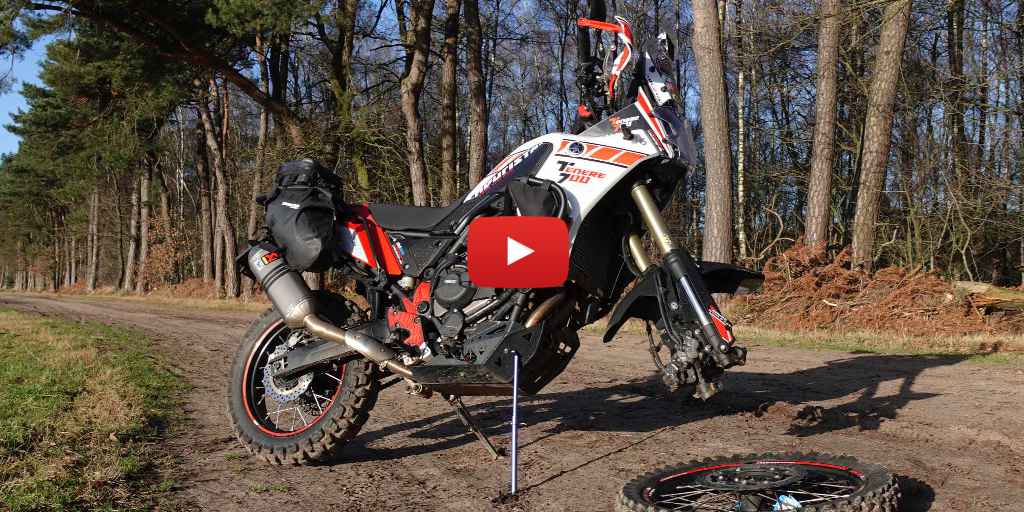Instructional video:

Manual (PDF)
The Story
Trail jacks have been a longstanding tool in the world of adventure riding. However, the Rolling Mavericks' UltraLight Enduro Trail Jack Stand takes the concept to a whole new level, representing my vision of a trail jack 2.0. As an avid rider who has relied on a homemade version for years, I never embark on a trail adventure without it.
This simple yet indispensable emergency tool is a game-changer when encountering a flat tire on the trail. It eliminates the need to search for rocks or sticks to lift your bike and becomes a must-have companion when riding in terrain devoid of trees or rocks.
Use
Using trail jacks is a breeze. To lift the rear wheel off the ground, start by securing the front brake with a Velcro strap wrapped around the brake lever and throttle. For a front-wheel lift, engage first gear to prevent the rear wheel from rolling. Adjust the tubes to the desired height to raise one wheel and secure them with a spring clip.
To elevate one of the wheels, simply push the bike with one hand, leaning it further onto the side stand on the opposite side. This action lifts one wheel off the ground, allowing you to position the trail jack under the swingarm or bash plate, depending on which wheel needs lifting.
The Good, the Bad, and the Ugly
Trail jacks are undeniably valuable tools, and I always carry one when going on moto camping trips. However, I've had two minor gripes with traditional trail jacks. Firstly, their weight. Most trail stands weigh anywhere from 250 to 450 grams, and when you're riding Enduro or embarking on long adventures with your fully loaded bike, every gram matters.
Secondly, the foot or Y support of trail jacks tends to be bulky. When permanently attached to the jack, they often become too long, thick, and wide, making it challenging to fit them into standard tool rolls.
The Rolling Mavericks' UltraLight Enduro Trail Jack Stand addresses these issues by offering an ultralight and compact design. The entire kit, including the spring clip and front brake Velcro strap lock, weighs a mere 140 grams. Additionally, it can be easily disassembled for effortless flat packing in your tool roll.
Using o-rings, the Trail Jack can be quickly assembled or disassembled. When assembled, these rings provide the perfect amount of friction to hold the different parts together securely. When disassembled, the foot is a mere 6 mm in height and can be packed completely flat.
The outer tube, at 18 mm, is the thickest part. The Rolling Mavericks' UltraLight Enduro Trail Jack Stand fits snugly next to my Motion Pro T6 tire levers inside my tool roll, occupying minimal space without adding significant weight.

It's All in the Details!
When it comes to the finer points, the UltraLight Enduro Trail Jack Stand truly excels! Usually, the Velcro strap used for locking up the front brake when lifting the rear wheel is wide and thick, resulting in a bulky packing experience. Moreover, it often features one-sided Velcro, making it a fiddly task to install. However, with the UltraLight Enduro Trail Jack Stand, we've taken a different approach. It utilizes a thin and narrow, 12 mm double-sided Velcro strap, eliminating the need for fumbling and ensuring a hassle-free brake lock.
Rest assured, the UltraLight Enduro Trail Jack Stand includes everything you need to make full use of this tool, including a stainless steel spring clip and spare o-rings.
Other Uses
Interestingly, I recently discovered an additional emergency use for the trail stand while packing my bike and accidentally tripping over my tent. As luck would have it, one of the tent poles broke, and to my surprise, the thinnest tube of the trail stand turned out to be the perfect temporary fix. I'm always eager to hear about other creative applications for the trail stand.
We'd love to hear how this tool, or any other tools, saved your day. Feel free to share your story with us at info@rollingmavericks.com.
Sounds intriguing, doesn't it? However, if you're still not convinced, if doubts linger about its ability to securely hold your bike off the ground, rest assured that you're not alone in wondering.
It's a question I'm frequently asked. But instead of simply telling you that it can, I believe in showing you the evidence. After all, seeing is believing :-)





